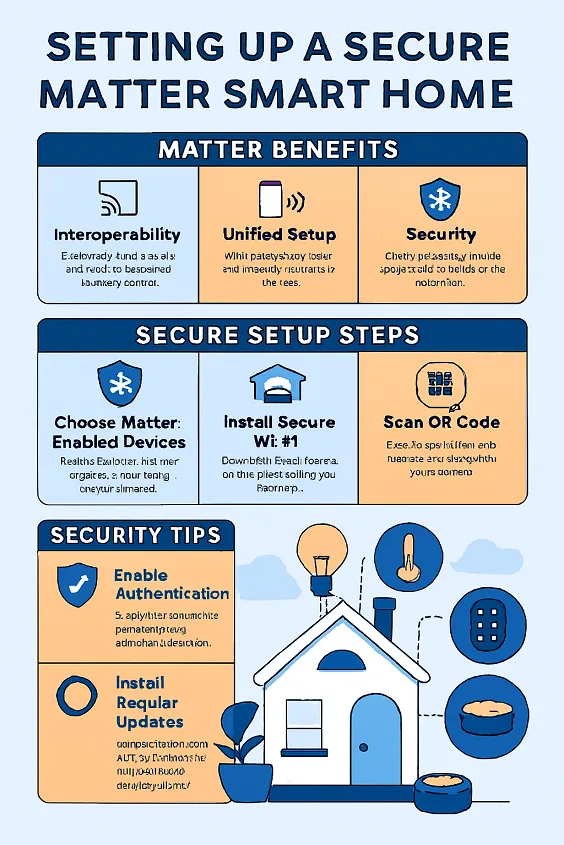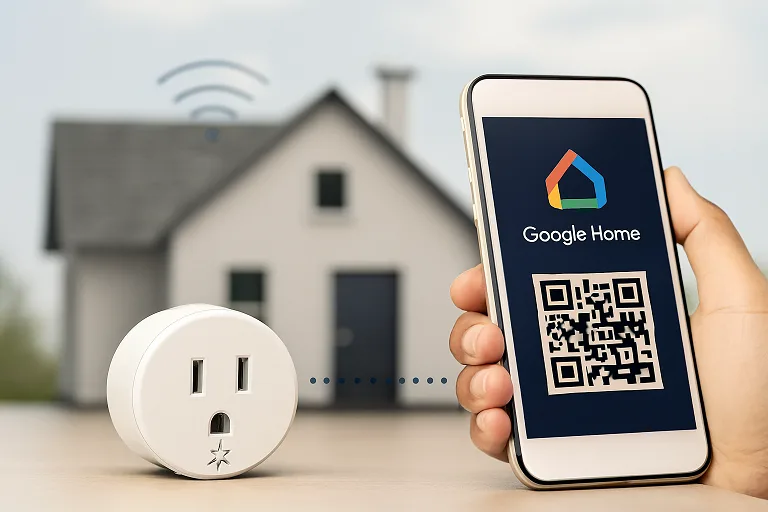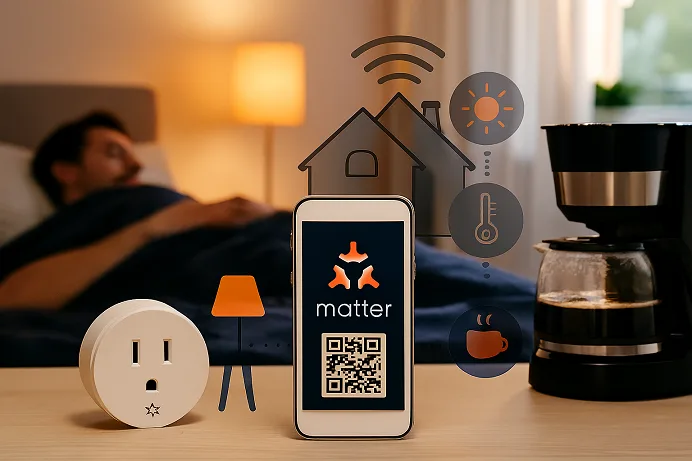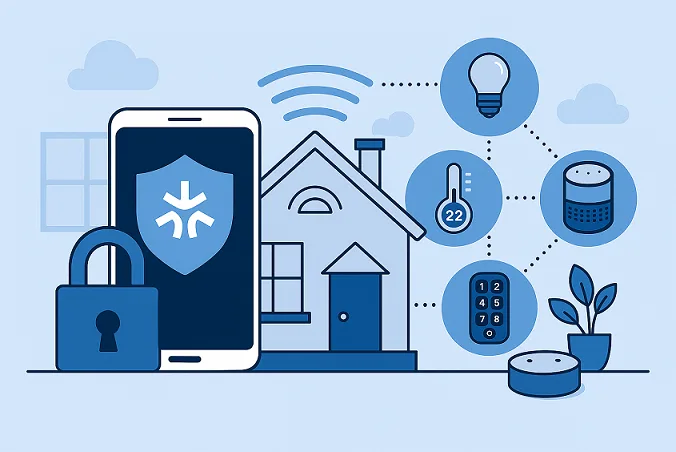If you have ever struggled with getting your smart devices to “talk” to each other, you are not alone. For a long time, the idea of a seamless smart home was held back by scattered ecosystems—one device might connect only with Google Home, another relied solely on Apple HomeKit, while others required separate apps or dedicated hubs. The result for many homeowners was a patchwork of gadgets that rarely worked in harmony, leading to frustrating setups, inconsistent automation, and constant troubleshooting.
Enter Matter—the new open-source connectivity standard developed by the Connectivity Standards Alliance (CSA) and supported by major players like Google, Apple, Amazon, and Samsung. Unlike older proprietary systems, Matter is designed to make devices from different brands work together securely, locally, and more efficiently. Whether you want to connect your smart lights, thermostats, or even door locks, Matter-compatible devices offer the promise of interoperability without forcing you into a single ecosystem.
What makes Matter especially exciting is its emphasis on simplicity and security. With features such as QR code onboarding, multi-admin support, and end-to-end encryption, setting up a Matter smart home is no longer reserved for tech experts—it’s accessible for beginners and scalable for advanced users.
In this complete practical guide, we will walk you step by step through planning, setting up, and securing your Matter-compatible smart home. By the end, you’ll not only understand how to get started but also how to build a future-proof system that grows with your needs.
- What Is Matter & What’s New in Matter 1.4.2
- Planning Your Secure Matter Smart Home
- Step-by-Step Setup of a Matter Smart Home
- Securing Your Matter Smart Home
- Common Pitfalls and How to Avoid Them
- Real-World Example: My Matter Smart Home Setup
- FAQs
- Conclusion: Building a Future-Proof Smart Home with Matter
What Is Matter & What’s New in Matter 1.4.2
What Is Matter?
At its core, Matter is an open, royalty-free smart home connectivity standard developed by the Connectivity Standards Alliance (CSA). Its purpose is simple but powerful: to ensure that smart devices from different brands—whether they are smart bulbs, plugs, thermostats, or door locks—can work together reliably, regardless of the platform. Unlike earlier standards like Zigbee or Z-Wave, which usually depended on brand-specific hubs, Matter devices can connect directly through Wi-Fi, Ethernet, or Thread. This makes setup quicker and reduces the usual compatibility issues. What makes Matter stand out is its true focus on interoperability—different brands and platforms finally working together without the extra hassle. A light switch certified under Matter will not only work with Apple Home, but also with Google Home, Amazon Alexa, or Samsung SmartThings—without extra configuration. This cross-platform flexibility is one of the biggest leaps forward in the history of the smart home ecosystem.
What’s New in Matter 1.4.2?
The first release of Matter laid the groundwork for a connected, reliable smart home, but the newer Matter 1.4.2 update builds on that base with meaningful improvements. One of the biggest changes centers on device onboarding—streamlining the process so that scanning a QR code now works faster and more consistently across different apps, adding both convenience and security to the setup experience. It also adds enhanced support for multi-admin control, allowing different family members to manage the same devices across their preferred ecosystems.
Another important update, a step forward in helping users optimize power consumption in Matter 1.4.2 is expanded compatibility with energy monitoring devices and appliances. Security has also been tightened with improved end-to-end encryption protocols and better firmware update handling, ensuring your Matter-compatible smart home remains safe against vulnerabilities.
What stands out about this version is that it reflects feedback from real users and developers. The CSA continues to evolve Matter not as a static product, but as a living standard shaped by collaboration, testing, and continuous improvement—making it clear that Matter is here to stay.
Planning Your Secure Matter Smart Home
Before rushing to buy new gadgets and start scanning Matter QR codes, it’s worth taking a step back to plan how you want your smart home ecosystem to function. Thoughtful preparation upfront not only helps you avoid unnecessary spending but also ensures that your Matter-compatible devices integrate smoothly, creating a setup that is both secure and built to last.
Assessing Your Smart Home Needs
Every home has its own set of priorities. For some, the journey begins with smart lighting and thermostats to cut down on energy costs, while others place security first with smart locks and connected cameras for added peace of mind. A good starting point is to write down the everyday routines you’d like to streamline—whether that means automating comfort settings, reinforcing home safety, or simply making life a little easier. Once you have clear goals, it becomes easier to choose devices that align with those needs and are certified under Matter.
Evaluating Network and Infrastructure
A Matter smart home relies on a strong foundation: your network. Devices may connect over Wi-Fi, Ethernet, or Thread, and each has its advantages. For example, Thread creates a low-power mesh network that boosts reliability for devices like sensors, while Wi-Fi provides higher bandwidth for video-based gadgets such as cameras. Ensuring your router is up-to-date and supports multiple connections will prevent bottlenecks as your system expands.
Privacy and Security Considerations
When creating a secure smart home, convenience should never be the only priority—safety must come first. Giving trusted family members access to manage devices without exposing your private login credentials enables multi-admin control, which is a practical way to keep your smart home secure. Just as important is staying current with firmware updates, since these often contain vital security patches that close gaps before they can be exploited. Finally, a safeguard that not only protects your data but also reinforces the long-term reliability of your Matter ecosystem is to look for device makers who clearly state their use of end-to-end encryption.
Planning for Scalability
One of the strengths of Matter is its ability to grow with you. Start small, with a single smart hub or speaker, then expand gradually by adding interoperable devices. By planning, you avoid the frustration of siloed systems and ensure your home remains flexible enough to embrace future Matter updates like 1.5 and beyond.
Step-by-Step Setup of a Matter Smart Home

Anyone who has dealt with the hassle of making devices from different brands work together knows how frustrating it can be. That’s why the thought of building a Matter smart home may feel a bit confusing at first. The good news is that Matter-compatible devices are designed for simplicity, with a standardized onboarding process that works across Apple Home, Google Home, Amazon Alexa, and Samsung SmartThings. Below is a practical, step-by-step approach to building your system the right way.
Step 1: Preparing Your Smart Home Ecosystem
Before unboxing your first Matter device, check whether your preferred ecosystem app is up-to-date. Platforms like Apple Home, Google Home, and Amazon Alexa have already integrated Matter support, but updates may include bug fixes and improvements that ensure smoother onboarding.
At this stage, also make sure your router and Wi-Fi network are stable. Make sure you have a compatible border router—commonly built into hubs such as the Apple HomePod mini or Google Nest Hub Max—before adding Thread-enabled devices to your setup. With this in place, your network can reliably support both high-bandwidth gadgets and low-power sensors without unexpected dropouts.
Step 2: Onboarding Your First Matter Device
One of the highlights of Matter is its QR code setup process. Instead of dealing with multiple brand-specific apps, you scan the QR code (or enter the numeric setup code) in your ecosystem’s app. The device is then automatically recognized and added to your Matter smart home network.
Matter makes the setup process easier, which helps prevent mistakes and ensures that each device connects safely with strong encryption. Unlike older ways that needed you to enter passwords by hand or use an extra device, it takes away those extra steps and makes the whole process much simpler.

Step 3: Adding More Devices Seamlessly
Once your first device is up and running, adding others becomes effortless. Multi-admin support allows you to control the same device across multiple apps—so a smart plug set up in Google Home can also be managed from Apple Home without duplication.
This flexibility is especially helpful in multi-user households, where each person may prefer their own voice assistant or ecosystem. For example, one family member might use Alexa to turn on the smart thermostat, while another adjusts it through the Home app on their iPhone.
Step 4: Creating Automations and Scenes
A Matter-compatible smart home really works when automations are made. For instance, you might set up a routine where your smart lights dim automatically when your smart lock is engaged at night. Because Matter enables cross-brand communication, you no longer need to worry about whether your light bulbs and locks come from the same manufacturer.
Scenes can also group devices for one-touch control. Imagine tapping “Good Morning” on your phone and having your lights brighten, your blinds open, and your coffee maker start brewing—all synced under Matter.

Securing Your Matter Smart Home
Setting up a Matter smart home is only the first step. To truly enjoy the benefits of convenience and automation, you must ensure your connected devices remain secure, private, and reliable. Because Matter-compatible devices operate across multiple ecosystems, taking proactive measures is essential to safeguard your home and personal data.
Keeping Devices Updated
Regular firmware updates are your first line of defense. Updates often patch vulnerabilities and add new features, but many homeowners overlook them. Most ecosystem apps—whether Google Home, Apple Home, or Amazon Alexa—can notify you when devices require attention. Enabling automatic updates where available ensures your smart home network stays resilient.
Enabling Strong Authentication
Real security starts with how you take care of your account. However, Matter makes it easier with tools like QR codes and multi-admin access. Protect your system by using strong, unique passwords and turning on two-factor authentication (2FA) whenever it’s available. These actions help make sure that even if your login information is shared, others won’t be able to take over your devices.
Network Segmentation and Encryption
A good way to keep your smart home secure is to keep your connected devices on a separate Wi-Fi network. Many newer routers let you set up a guest or IoT network, which helps protect your system if one device gets hacked. Also, Matter uses strong encryption to keep communications between devices and apps private and safe from interference.
Building Trust in Your Ecosystem
It’s better to go with companies that are open and honest. Businesses that clearly explain their privacy practices, display security certifications, and back up Matter standards help build more trust. Partnering with these trusted companies—and following the right setup steps—helps you build a secure Matter smart home that runs smoothly while safeguarding the people and data that matter most.
Common Pitfalls and How to Avoid Them
A frustrating situation arises when many homeowners face issues when setting up their smart home, even though Matter is simple to use, which can be quite frustrating. Spotting these common problems early on can help you save time and avoid unnecessary hassle, making the whole process much easier and more enjoyable.
Over-Reliance on One Brand
A common mistake people make is purchasing all their devices from just one brand. Although this might seem easier but it reduces the flexibility of the system to be used with other options. For example, a homeowner once found out their favorite brand had stopped making a particular product, which left their setup missing key parts. The solution is straightforward: choose Matter-compatible devices from different brands, because they will still work together smoothly.
Network Placement Mistakes
Poor router placement is one of the most frequent smart home mistakes. A Wi-Fi hub hidden in a cabinet can cause devices to drop offline. I once helped a friend who couldn’t keep their smart plugs connected—relocating the router to a central space solved the issue instantly.
Naming Chaos with Devices
Naming each light “Lamp” confuses the system. I’ve seen families yelling at voice assistants because commands triggered the wrong device. The fix is to use descriptive names like “Kitchen Pendant” or “Bedroom Desk Lamp.” Clear naming makes Matter troubleshooting much easier.
Ignoring Power and Energy Consumption
Smart homes can quietly increase energy costs if not managed properly. One of my clients was surprised by the hidden energy use from always-on smart speakers. By using devices that track energy consumption and reviewing app reports, they were able to adjust their usage for better efficiency without giving up the convenience these devices offer.
Real-World Example: My Matter Smart Home Setup
When I first began experimenting with a Matter home example, I wanted to test whether devices from different brands could finally work together without headaches. My system started with a Google Nest Hub Max acting as a Thread border router, a pair of Philips Hue smart bulbs, a Yale smart lock, and a TP-Link Kasa smart plug. Using Apple Home on my iPhone, I was able to scan the Matter QR codes and onboard everything within minutes. The devices synced not just in Google’s ecosystem but also appeared automatically in the Home app—a practical smart home case study of Matter’s promise of true interoperability.
The daily benefits quickly became clear. I created a simple automation where locking the Yale door at night triggered the lights to dim and the Kasa plug to turn off the coffee machine. No more worrying if something was left running. Equally valuable was the ability for my partner to control the same devices through her Amazon Alexa without any duplicate setup.
Of course, there were minor limitations. Some legacy devices without Matter support still required their own apps, and occasional firmware updates caused short interruptions. But overall, this Matter home example proved that the technology delivers on its vision of simplicity, security, and flexibility.
FAQs
Conclusion: Building a Future-Proof Smart Home with Matter
As we’ve explored, Matter is more than just another protocol—it represents the foundation of the future of Matter smart home technology. By prioritizing security, interoperability, and ease of use, Matter ensures devices from different brands finally work seamlessly together.
The future doesn’t have to feel too much to handle. Begin with a couple of devices that work with Matter, like smart plugs or bulbs, and slowly add more as you feel more comfortable. This step-by-step approach allows you to scale into a truly complete smart home guide in action, tailored to your lifestyle and needs.
Most importantly, even beginners can achieve a reliable setup without needing deep technical expertise. With every new update, Matter grows stronger, offering both stability today and confidence for tomorrow. By adopting it now, you’re investing in a smarter, safer, and more connected living space that’s built to last.


